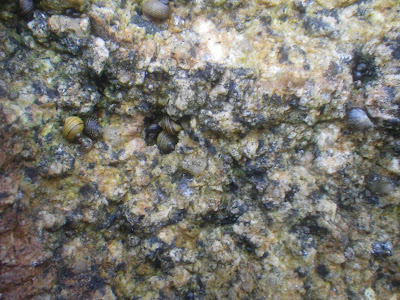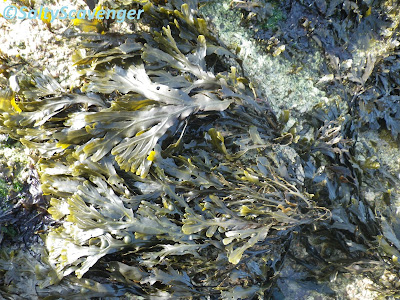 |
| Small and rough periwinkles together with sparse barnacles on the larger boulders of the upper shore. |
 |
| Springtails investigate a crack in the shell of a rough periwinkle. |
 |
| Thick topshells (Osilinus lineatus) among the boulders and cobbles. |
 |
| Osilinus lineatus |
 |
| Osilinus lineatus |
 |
| Porphyra spp |
 |
| Ulva spp |
 |
| LR.MLR.BF (Barnacles and fucoids on moderately exposed shores) EUNIS: A1.21. |
 |
| Some areas of the shore are showing seasonal die back of fucoids. |
 |
| Fucus spp (Fucus vesiculosus var. nana?) |
 |
| Fucus spp (Fucus vesiculosus var. nana?) |
 |
| Understory reds. |
 |
| A dog whelk (Nucella lapillus) |
 |
| Verrucaria mucosa |
 |
| Limpets (Patella sp) and beadlet anemones (Actinia equina) |
 |
| Fucus serratus, Mastrocarpus stellatus and ephemeral greens. |
 |
| Fucus serratus, Mastrocarpus stellatus, Rhodothaminiella floridula and ephemeral greens. |
 |
| Mastrocarpus stellatus |
 |
| Gigartinales |
 |
| Cladophora rupestris |
 |
| Ulva spp in a sediment filled rockpool. Habitat classification: LR.FLR.RKP.SwSed (Seaweeds in sediment floored eullitoral rockpools) EUNIS: A1.413. |
 |
| Sand tolerant seaweeds in a sediment filled rockpool. |
 |
| Phyllophoracea |
 |
| Hypoglossum hypoglossoides |
 |
| Rhodothaminiella floridula |
 |
| Porphyra spp |
 |
| Black scour weed (Ahnfeltia plicata) |
 |
| Gigartinales |
 |
| Gigartinales |
 |
| Gigartinales |
 |
| Gigartinales |
 |
| Gigartinales |
 |
| Cystoclonium purpureum |
 |
| Ceramium spp |
 |
| Asparagopsis armata |
 |
| Corallina sp form turf in the lower shore rockpools. |
 |
| Corallina officinalis |
 |
| Corallina spp |
 |
| There were no signs of the tube dwelling amphipods among the seaweeds of the sediment filled pools, only the cases of thier tubes remained. |
 In June, 2015 there were a number of amphipods encased within tubes that were in turn enveloped among the green seaweed. |
 |
| Asteria rubens |
' |
| Barnacle communities cover more exposed rocks of the lower shore. Habitat classification: LR.HLR.MusB (Mussel and/or barnacle communities). |
 |
| Barnacles |













